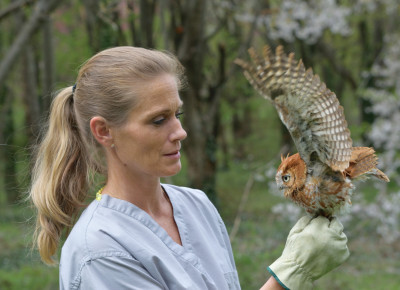A Trill Sounds In The Night
Chances are you’ve never seen an Eastern Screech Owl but you have probably heard one. This tiny owl has a voice of a bird many times its size. Their haunting trill sounds at dusk and continues through the night and into the very early morning. Like most owls, Eastern Screech Owls are nocturnal. They hunker down in tree cavities and spend their days sleeping. At night, Eastern Screech Owls emerge from their nests to search for food.
Eastern Screech Owl / Archive.org/ CC BY 3.0 US
The Cosmopolitan Owl
Eastern Screech Owls are one of the few birds that have adapted well to the changing landscape of our modern world. Almost any habitat with enough tree cover makes a good home for a Screech Owl. They are equally happy to find an open tree cavity or nest box in the woods or in someone’s back yard.
The Eastern Screech Owl is so well adapted to modern living that it can be found in rural farmland, forests, suburban neighborhoods, and city parks. They will eat whatever is readily available and if prey is plentiful, they will cache extra food in tree holes. According to the Cornell Lab of Ornithology, an Eastern Screech Owl’s diet can include:
- Invertebrates such as: earthworms, insects, crayfish, tadpoles, frogs, and lizards.
- Small mammals such as: rats, mice, squirrels, moles, and rabbits.
- Small songbirds such as: flycatchers, swallows, thrushes, and finches.
- Larger birds such as jays, grouse, doves, shorebirds, and woodpeckers.
Despite it’s impressive ability to adapt to different habitats, the city is still a dangerous place for an owl and even the most skillful bird occasionally runs into trouble.
An Off Day For An Owl
On Sunday April 5th, City Wildlife got a call. A small Eastern Screech Owl had been found in the fishing cat’s enclosure at the Smithsonian National Zoo. The zoo vet who made the call reported that the owl was extremely dehydrated, but had no significant injuries.
When the bird arrived it was minimally responsive. An initial exam revealed that the bird had sustained a small wound. We provided treatment for both the dehydration and the injury and over the next few days the bird had a fairly quick recovery. Nine days after intake the bird was released!

This is an example of an ideal situation. Often times, birds are not so lucky.
Dehydration Is A Serious Problem For Birds
Although the small wound on the Screech Owl was concerning, the animal’s hydration status posed a more immediate threat. Dehydration in birds, like in humans or other animals, can severe and in some extreme cases can even be fatal.
We are grateful to the Smithsonian National Zoo for identifying that this bird was in need, providing it with initial supportive care and then referring it to City Wildlife.



We have one in our side yard that shrinks away at dusk and into the night. It’s call is so beautiful. We have so much foliage for it to hide and nestle in.
In 2016 I was driving to town on a long wooded back road I rarely traveled. About 10:30 am. I passed by what I thought was a guinea pig sitting on the side of the road so I turn around and it was a Screech o
Owl. I knew it was hurt so I got a towel draped it over him picked him up and took him to the Vet. I kept saying “it’s ok baby I’m going to get you help”. I put him in a large sack and off we went. Later I was told Wildlife had to put it down because of a shattered wing. He was very alert and was so sweet. He seemed grateful that I stopped to help. Why would they have to put him down?
He probably permanently lost some ability he needed for survival: sight, hearing, ability to fly, use of his legs. Only the vet or rehabber would know for sure.